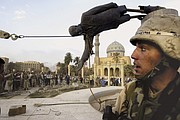BAGHDAD (AP) — It's been 20 years since the U.S.-led invasion of Iraq began. Here are some key dates from the invasion and following developments.
MARCH 20, 2003
The invasion is launched, and Baghdad is attacked with missiles and bombs in an attempt to target Saddam Hussein and bring down the government.
APRIL 9, 2003
American troops storm Baghdad, and the statue of Saddam is toppled in Firdous Square in a symbolic collapse of his government.
MAY 1, 2003
U.S. President George W. Bush declares an end to major combat operations in Iraq.
AUGUST 2003
Initial hopes for peace recede. An anti-coalition insurgency begins in earnest. Attacks include a car bombing of the Jordanian embassy; a truck bomb that demolishes the United Nations headquarters in Baghdad and kills top U.N. envoy Sergio Vieira de Mello; and the bombing of a Najaf shrine that kills more than 85 people, including Shiite leader Ayatollah Mohammed Baqir al-Hakim.
DECEMBER 2003
Saddam is captured in an underground hideout near Tikrit.
MARCH 2004
Violent resistance to the U.S. presence intensifies. Four security contractors are ambushed and killed in Fallujah, prompting a battle for the insurgent-dominated city west of Baghdad. Al-Qaida in Iraq, a militant Sunni movement that attracts some of Saddam's former Baathist security forces, leads the insurgency.
APRIL-AUGUST 2004
Clashes emerge between U.S.-led coalition forces and followers of Shiite cleric Moqtada al-Sadr, who demands that foreign forces leave Iraq.
OCTOBER 2004
U.S. arms inspector David Kay reports his team has found no evidence of stockpiled weapons of mass destruction.
NOVEMBER 2004
Following the failure of a first U.S. campaign for Fallujah, a second battle destroys much of the city but leaves the U.S. in control.
JANUARY 2005
Iraqis select a new parliament in the first elections since the fall of Saddam. Shiite and Kurdish parties take an overwhelming majority after Sunnis largely boycott.
DECEMBER 2005
Fighting takes on the character of a sectarian civil war between Shiites and Sunnis, with ethnic cleansing, killings and terror attacks in mixed neighborhoods. The death toll mounts around the country over the next two years among insurgents, coalition forces and Iraqi civilians.
JANUARY 2007
After enlisting sympathetic Sunni tribal leaders to oppose the anti-coalition insurgency in the so-called Sunni Awakening, President Bush orders a surge of 30,000 U.S. troops to contain the spreading violence.
LATE 2008
After a year of escalating chaos, coalition forces begin to root out both al-Qaida and Shiite militias opposing the elected government. Barack Obama is elected U.S. president on a promise to withdraw U.S. forces.
DECEMBER 2010
After much political turmoil, Shiite politician Nouri al-Maliki wins second term as prime minister, supported by al-Sadr.
DECEMBER 2011
The last U.S. troops leave Iraq, turning responsibility for security over to the Iraqi army and police.
2013-2018
From the remnants of al-Qaida in Iraq, a new terrorist force emerges. The Islamic State of Iraq and Syria breaks Sunni militants out of prisons and mounts a battle to establish a worldwide Islamic State caliphate based in Syria. In Iraq, the Islamic State group takes over Mosul, Fallujah, Tikrit and Ramadi with lightning speed, ultimately controlling about 40 percent of the country. A U.S. bombing campaign, special forces operations and Shiite militias allied with Iran turn back the tide. Islamic State group is evicted from strongholds in northern Iraq and in Syria, although skirmishes continue in remote areas.
OCTOBER 2019-JANUARY 2020
With the battle against the Islamic State group mostly ended, Iraqi public dissatisfaction boils over with anti-government protests against rampant corruption, poor services and unemployment erupting in Baghdad and the predominantly Shiite south. The demonstrations draw young men and women who camp out alongside each other, a rare occurrence in the conservative, majority-Muslim country.
JANUARY 3, 2020
The U.S. assassinates top Iranian Gen. Qassim Soleimani, head of the Quds Force expeditionary forces, in a drone strike near the Baghdad airport. Iraqi militia commander Abu Mahdi al-Muhandis also is killed in the attack, bringing tensions between the U.S. and Iraq to a fever pitch, and later fragmenting rival Shiite camps.
OCTOBER 2022
After a year of political stalemate following 2021 elections, the Shiite-dominated parliament chooses Kurdish leader Abdul Latif Rashid as president. He nominates Shiite politician Mohammed Shia al-Sudani as prime minister. Al-Sudani forms a government, promising to fight corruption and improve living standards.

